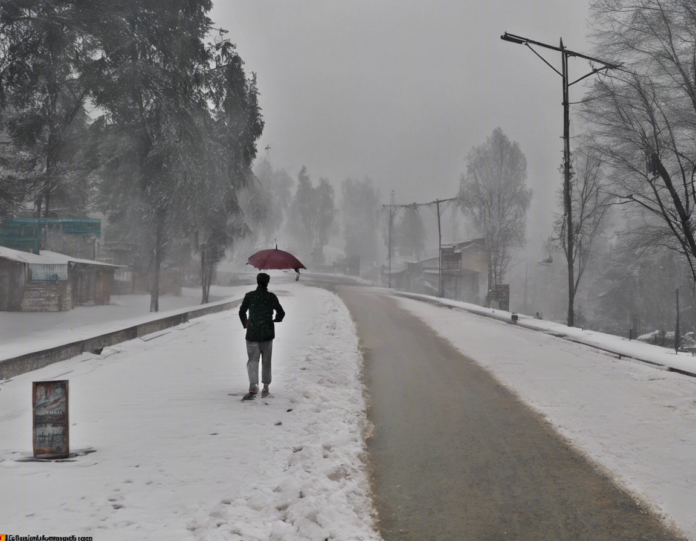Introduction
Kashmir, often referred to as “Paradise on Earth,” is not only famous for its breathtaking natural beauty, but also for its diverse and unique weather conditions. Located in the northern part of India, Kashmir experiences a variety of weather patterns throughout the year due to its geographical location and topography. In this comprehensive guide, we will delve into the weather in Kashmir, covering everything from its seasonal variations to the best time to visit this enchanting region.
Understanding the Climate of Kashmir
Kashmir experiences a subtropical highland climate, characterized by four distinct seasons: spring, summer, autumn, and winter. Each season brings its own charm and challenges, making Kashmir a year-round destination for tourists seeking diverse experiences.
- Spring (March to May)
- Spring in Kashmir is a magical time when the valley comes alive with blooming flowers and lush greenery.
- Temperature: Daytime temperatures range from 15°C to 25°C, while nights can be cool with temperatures dropping to around 5°C.
- Weather: The weather is mild and pleasant, making it ideal for sightseeing and outdoor activities.
-
What to Pack: Light jackets, sweaters, and comfortable shoes for exploring the scenic beauty of Kashmir.
-
Summer (June to August)
- Temperature: Summer in Kashmir is warm but not uncomfortably hot, with daytime temperatures averaging between 25°C to 35°C.
- Weather: The days are long and sunny, perfect for exploring the alpine meadows, lakes, and mountains.
-
What to Pack: Light and breathable clothing, sunscreen, sunglasses, and hats for protection against the sun.
-
Autumn (September to November)
- Autumn in Kashmir is characterized by cool days and crisp evenings, with the landscape turning into a canvas of vibrant hues.
- Temperature: Daytime temperatures range from 10°C to 20°C, while nights can be chilly with temperatures dropping to 0°C.
- Weather: The clear skies and pleasant weather make autumn the perfect time for photography and nature walks.
-
What to Pack: Layered clothing, including sweaters, jackets, and scarves, as the weather can be unpredictable.
-
Winter (December to February)
- Temperature: Winters in Kashmir are cold and snowy, with daytime temperatures hovering around 0°C to 10°C and nighttime temperatures falling below freezing.
- Weather: The region receives heavy snowfall, transforming Kashmir into a winter wonderland ideal for skiing, snowboarding, and other winter sports.
- What to Pack: Heavy woolens, insulated jackets, snow boots, and thermals to stay warm and cozy.
Best Time to Visit Kashmir
While Kashmir is a year-round destination, the best time to visit depends on your preferences and interests. Here are some recommendations based on the different seasons:
- Spring (March to May): Ideal for nature lovers and those interested in witnessing the blooming tulips at the Indira Gandhi Memorial Tulip Garden in Srinagar.
- Summer (June to August): Perfect for adventure enthusiasts looking to explore the high-altitude lakes, trekking trails, and lush meadows of Kashmir.
- Autumn (September to November): Recommended for photographers and landscape enthusiasts to capture the hues of the changing leaves against the backdrop of snow-capped mountains.
- Winter (December to February): A paradise for winter sports enthusiasts with opportunities for skiing, snowboarding, and snowshoeing in famous resorts like Gulmarg.
Weather-Related Activities in Kashmir
In addition to exploring the natural beauty of Kashmir, there are several weather-related activities that visitors can enjoy based on the season:
- Spring: Attend the Tulip Festival in Srinagar, go for shikara rides on Dal Lake, and visit the Mughal Gardens to witness the blooming flowers.
- Summer: Take a Gondola ride in Gulmarg, go camping in Sonmarg, and trek to the stunning Thajiwas Glacier.
- Autumn: Visit the saffron fields in Pampore, explore the apple orchards in Gulmarg, and take a leisurely stroll along the Lidder River in Pahalgam.
- Winter: Enjoy skiing and snowboarding in Gulmarg, take a ride on the Gulmarg Gondola, and experience the winter charm of the old city in Srinagar.
Tips for Weather-Appropriate Travel
To make the most of your trip to Kashmir, here are some tips for weather-appropriate travel:
- Check the Weather Forecast: Stay updated on the weather conditions in Kashmir to pack accordingly and plan your activities.
- Dress in Layers: Weather in Kashmir can be unpredictable, so dress in layers to stay comfortable throughout the day.
- Stay Hydrated: Drink plenty of water, especially at higher altitudes, to stay hydrated and prevent altitude sickness.
- Protect Yourself from the Sun: Apply sunscreen, wear sunglasses, and carry a hat to protect yourself from the strong UV rays at higher altitudes.
- Respect Nature: Follow the local guidelines for responsible tourism and help in preserving the natural beauty of Kashmir for future generations.
Frequently Asked Questions (FAQs)
- Is it safe to visit Kashmir considering its political situation?
Yes, while the region has faced security concerns in the past, tourist areas in Kashmir are generally safe for visitors. It is advisable to stay informed about the current situation and follow travel advisories before planning your trip.
- What is the best way to reach Kashmir?
Srinagar has an international airport with flights connecting major cities in India. Additionally, you can reach Kashmir by road via national highways or by train to Jammu, followed by a road journey to Srinagar.
- Are there any health precautions to take before traveling to Kashmir?
It is recommended to consult your healthcare provider regarding vaccinations and medications for altitude sickness before traveling to Kashmir, especially if you plan to visit high-altitude areas.
- Can I witness snowfall in Kashmir?
Yes, Kashmir receives heavy snowfall during the winter months, transforming the region into a winter wonderland. Popular destinations like Gulmarg and Sonmarg are known for their snowy landscapes and winter activities.
- What are the must-visit attractions in Kashmir?
Some of the must-visit attractions in Kashmir include Dal Lake and Mughal Gardens in Srinagar, Gulmarg for skiing and Gondola rides, Pahalgam for nature walks, and Sonmarg for its pristine beauty.
- Is it necessary to hire a local guide for exploring Kashmir?
While not mandatory, hiring a local guide can enhance your experience in Kashmir by providing insights into the local culture, history, and hidden gems that may not be easily accessible to tourists.
- What are the accommodations like in Kashmir?
Kashmir offers a range of accommodations, including luxury hotels, houseboats on Dal Lake, guesthouses, and homestays, catering to different budgets and preferences of travelers.
- Can I experience the local cuisine in Kashmir?
Yes, Kashmir is known for its flavorful cuisine, including dishes like Rogan Josh, Wazwan, Kashmiri Pulao, and Kahwa tea. Don’t miss the opportunity to savor the authentic flavors of Kashmiri cuisine during your visit.
- Are there any cultural etiquettes to keep in mind while visiting Kashmir?
It is advisable to respect the local customs and traditions in Kashmir, including dressing modestly, seeking permission before photographing locals, and being mindful of local sensitivities to ensure a harmonious travel experience.
-
What are some shopping experiences to enjoy in Kashmir?
Kashmir is famous for its handicrafts, including Pashmina shawls, carpets, woodwork, and saffron. Explore the local markets in Srinagar, Pahalgam, and Gulmarg for authentic Kashmiri souvenirs to take back home.
Conclusion
In conclusion, exploring the weather in Kashmir offers a unique opportunity to witness the diverse climate patterns of this enchanting region, from blooming springs to snowy winters. By understanding the seasonal variations, best time to visit, and weather-related activities, you can plan a memorable trip to Kashmir that caters to your preferences and interests. Whether you’re a nature lover, adventure enthusiast, or culture seeker, Kashmir has something to offer for every traveler, making it a destination worth experiencing at least once in a lifetime.












